Featured Articles
- 01 How to Install, Initialize and Partition SSD
- 02 How to Clone HDD to SSD
- 03 How to Migrate OS from HDD to SSD
- 04 How to Format SSD on Windows
- 05 How to Securely Erase SSD
- 06 How to Install Windows 10/11 on SSD
- 07 Use SSD and HDD Together on Windows 11/10
- 08 How to Free Up Space on SSD in Windows
- 09 SSD Fix 1: Repair Corrupted SSD
- 10 SSD Fix 2: SSD Not Initialized
- 11 Repair and Restore Not Working/Failed/Dead SSD
SSD, also known as Solid-State Drive, uses flash memory to deliver vastly superior performance and durability. It's faster and more durable than normal HDDs. With these advantages, SSDs are exceeding traditional HDDs, becoming computer manufacturers' love.
For most users, SSD partitioning is not an easy task. Let's see what we need to prepare to partition an SSD:
| ⚙️Complex Level | Low, Beginners |
| ⏱️Duration | 3-5 minutes |
| 💻Applies to | Partition an SSD when SSD is uninitialized, unallocated, and partitioned. |
| 🧩Preparations | Windows PC, SSD, EaseUS Partition Master |
| 🧰Cases |
Thus, with more PCs shipped with SSD coming on the market, partitioning SSD to fully use SSD becomes a new issue. And you can address it here with the complete guide in Windows 11/10.
Should I Partition SSD?
Before we start officially partitioning SSDs, some users may have the question: should I partition my SSD in Windows 11/10?
Partitioning an SSD is not a bad idea. But the fact is that SSDs don't need to be partitioned to get a performance boost. Because SSDs have no moving parts, they do not have a "fast partition" or "slow partition" section. The speed is the same regardless of where you store your files in the drive.
Whether or not you partition your SSD depends largely on each individual's needs. If you are still unsure, please check out the benefits of SSD partitioning directly. If you've decided to partition SSD, you can prepare the partition tool - EaseUS Partition Master in advance:
To help you start with this task, follow the next two parts to make partitions on SSD now. First, we need to check the state of your SSD:
Part 1. Check The State of Your SSD
The ways to partition SSD may differ based on your SSD disk's state. Let's check the state of your SSD first in Disk Management:
Step 1. Install SSD to your computer correctly via the connection cable.
Step 2. Restart the PC, right-click "This PC/My Computer" > "Manage."
Step 3. Click Disk Management and check the state of your SSD:

- Unallocated: It means your SSD is initialized, and you can directly create partitions on it.
- Not Initialized: This means that you need to initialize the SSD first before creating partitions.
- Partitioned: It means you have partitions on SSD, and you need to resize and repartition SSD.
Next, we will provide step-by-step guides to partition SSD safely. If you think this passage is helpful, share it with other people in need!
And you can follow the complete guide in the next part to start partitioning your SSD now.
Part 2. How to Partition SSD Safely & Easily
It's not like making folders. You know, creating and resizing partitions is a hassle. Here, you can follow the respective guide to partition SSD by using partition software or Disk Management easily in Windows 11/10:
#Guide 1. SSD Shows Unallocated - One-Click to Partition SSD & Create New Volumes
✔️Tool: EaseUS Partition Master
✔️Read Time: 30-40s
✔️How many steps: 3
If your SSD displays as unallocated in Disk Management, the computer will regard it as a brand-new disk. To use it, you need to create partitions on the drive.
Here, we'd like to show you how to partition unallocated SSD with only one click with the help of EaseUS Partition Master. Its New Disk Guide makes partition SSD safe and easy:
Step 1. Open EaseUS Partition Master, go to Partition Manager and click "Partition this disk" on the popped-up New Disk Guide window.
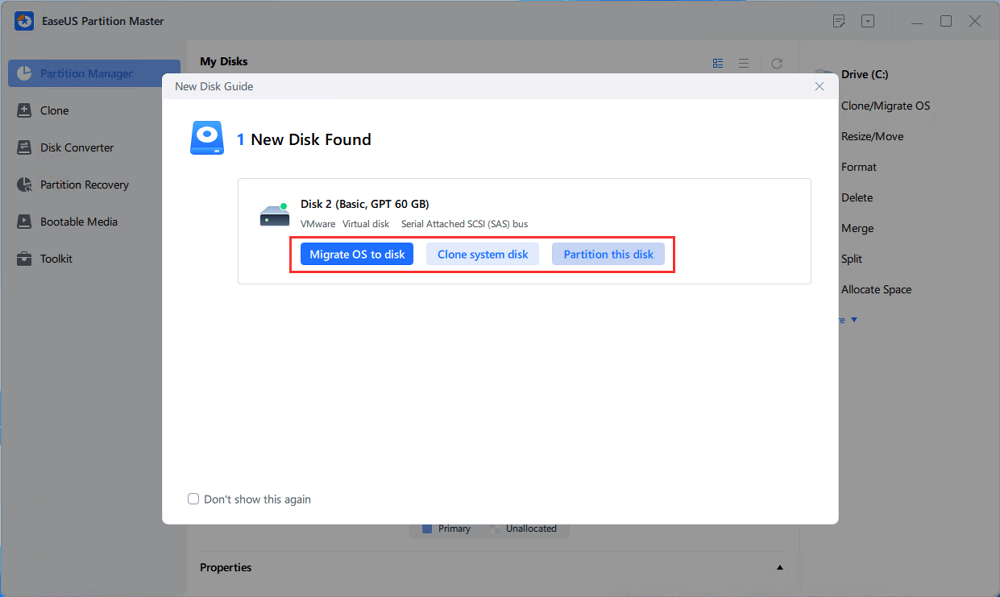
Step 2. Set the number of partitions you need to create, and set the partition style to your disk - MBR or GPT.
Or, you can accept the default setting offered by EaseUS Partition Master. Once done, click "Proceed".
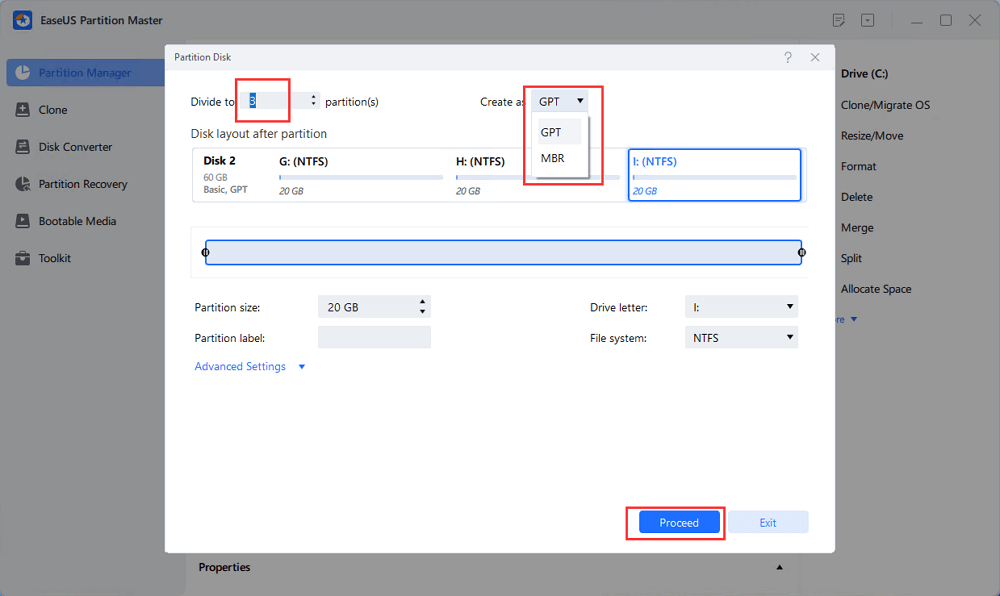
Step 3. Click "Execute 1 Task" and "Apply" to finalize partitioning the new HDD/SSD or external disk.
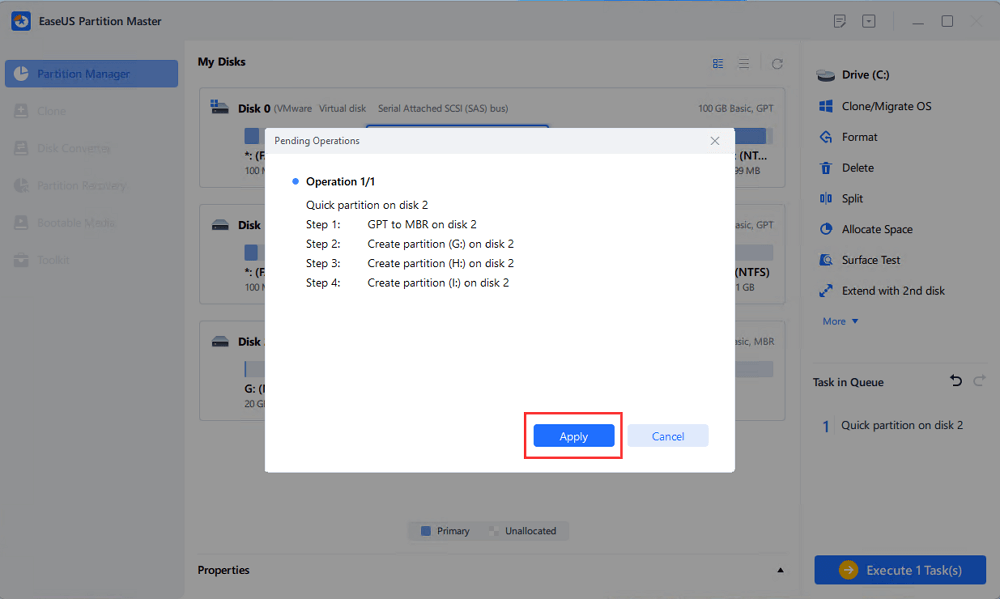
After this, you can install OS, applications, or personal files to the SSD partition flexibly.
In addition to disk partitioning, you can use other features in EaseUS Partition Master to make use of your SSD disk:
- Migrate OS to SSD/HDD
- Convert Disk/Partitions
- merge SSD partitions
- Recover lost partitions, etc.
You May Also Like:
How to Partition Hard Drive in Windows 11/10
Data Recovery is not a challenge anymore. EaseUS is a dependable data recovery application that retrieves lost data with simple clicks.

#Guide 2. SSD Shows Not Initialized - Initialize SSD
✔️Tool: Disk Management
✔️Read Time: 30s
✔️How many steps: 3
If your SSD shows not initialized in Disk Management, you'll need to initialize the disk first. Then follow #Guide 2 to create new partitions on it.
Here are the steps to initialize SSD in Disk Management:
Step 1. Right-click"This PC/My Computer," click "Manage," and click "Disk Management."
Step 2. Right-click the not initialized SSD and select "Initialize SSD".

Step 3. Set "MBR" or "GPT" for SSD, and click "OK" to confirm.
What partition style should I use for SSD? Basically, if you only want to create 1 or 2 partitions, MBR is good. But if you want to create multiple partitions or install the latest Windows 11/10 on SSD, choose GPT. For more information, learn MBR vs GPT.
After initializing the SSD, you can follow #Guide 2 to create partitions on your SSD.
#Guide 3. SSD Shows Partitioned - Resize and Partition SSD
✔️Tool: EaseUS Partition Master, Disk Management
✔️Read Time: 30s, 50s
✔️How many steps: 3, 5
Note that if you have already created partitions on SSD and you want to reallocate the disk space, you can turn to EaseUS Partition Master or Disk Management for help.
For an easier solution, the EaseUS partition tool is a better choice.
Way 1. Partition SSD with EaseUS Partition Tool
With this tool, you can format SSDs for various file systems. Partition SSD to multiple partitions with 4K alignment, clone SSD, etc. Now, you can directly download EaseUS Partition Master and follow the steps to partition it.
Step-by-Step Guide to Re-Partition SSD
Step 1. Launch EaseUS Partition Master to check for free space at the Partition Manager section.
- If your hard drive has unallocated space, jump to Step 3 to create partition.
- If the hard drive has no unallocated space, continue with Step 2.
Step 2. Shrink a disk partition to create unallocated space.
Right-click on the target drive partition with a lot free space and select "Resize/Move".
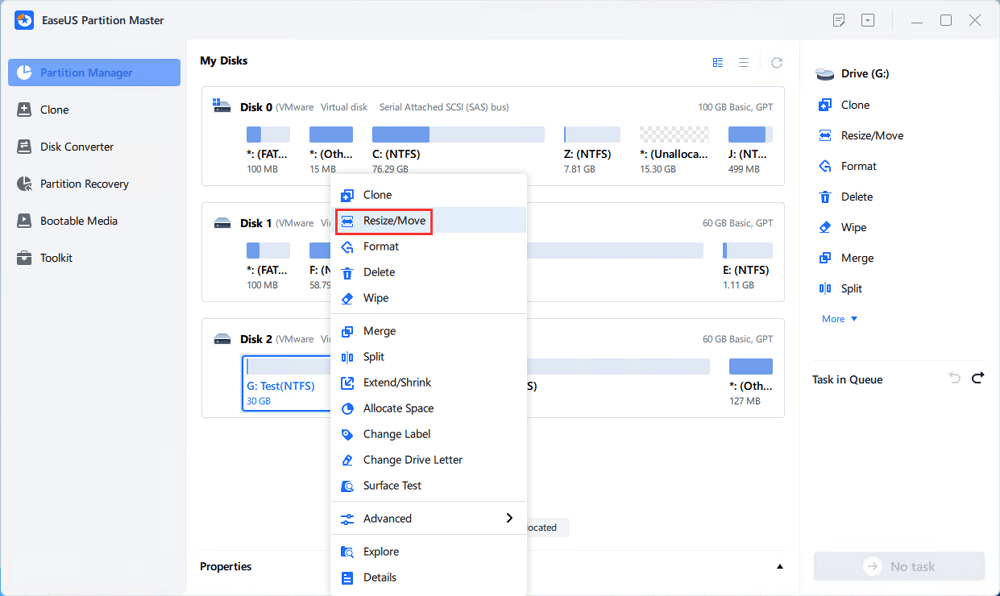
Drag either end of the partition rightwards or leftwards to shrink the partition size so as to get ample unallocated space. You can visually know how much space you've decreased in the "Size of partition" area. Click "OK".
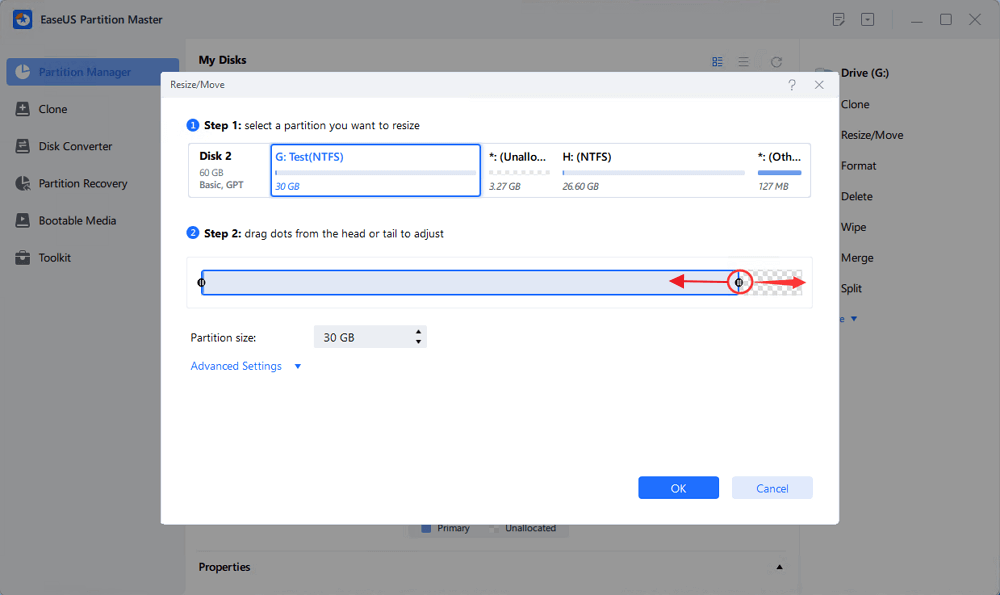
Click "Execute xx Task" and then "Apply" to save all the changes.
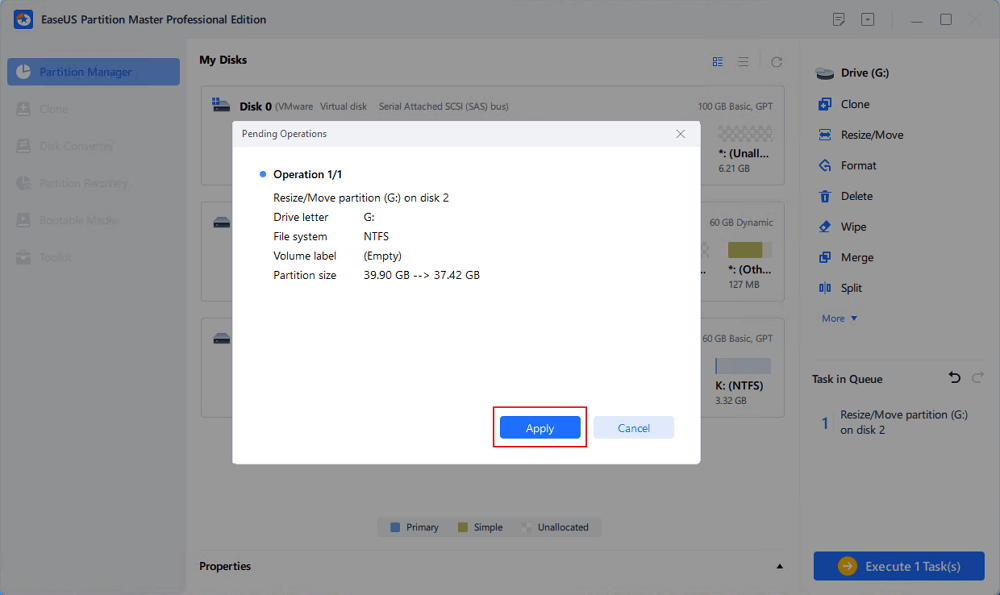
Go back to Partition Manager, there should be unallocated space appearing on the same disk and you can continue with the next step to create new partition on your hard drive.
Step 3. Create a new partition with unallocated space on the target hard drive.
Right-click on the unallocated space and choose "Create".
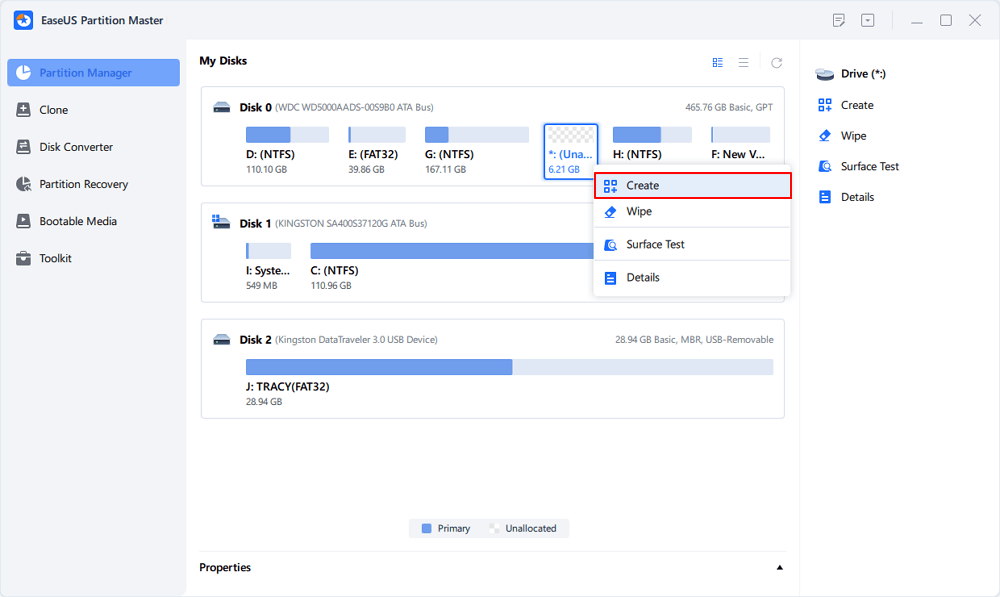
Customize the partition size, partition drive letter, partition label, file system (NTFS, FAT32, EXT2/3/4, exFAT) and more in the Advanced Settings. Click "OK".
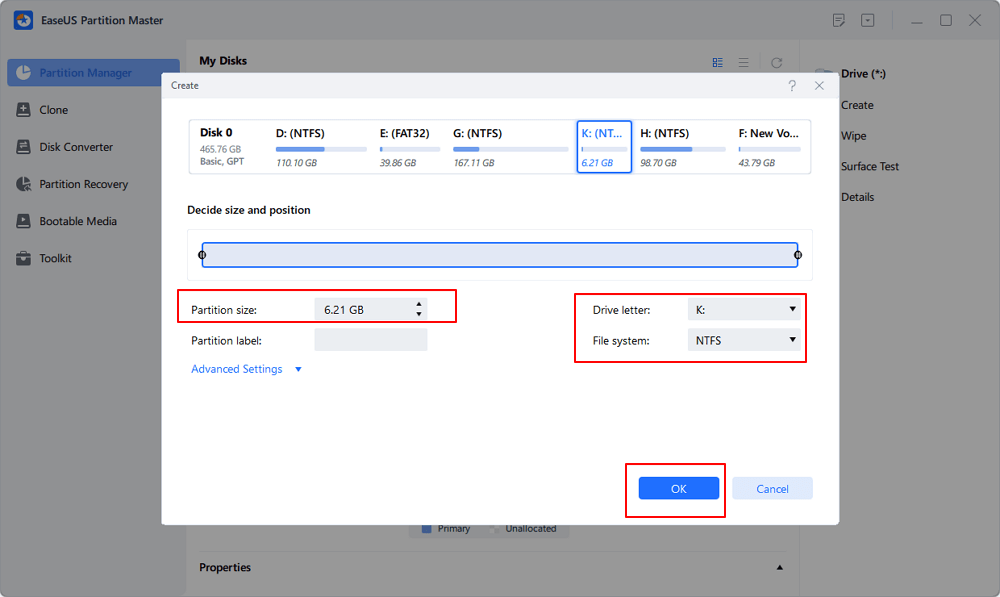
Finally, click "Execute * Task" and "Apply" to complete creating partition with the unallocated space on your disk. Repeat the steps to partition a hard drive and get many more partitions.
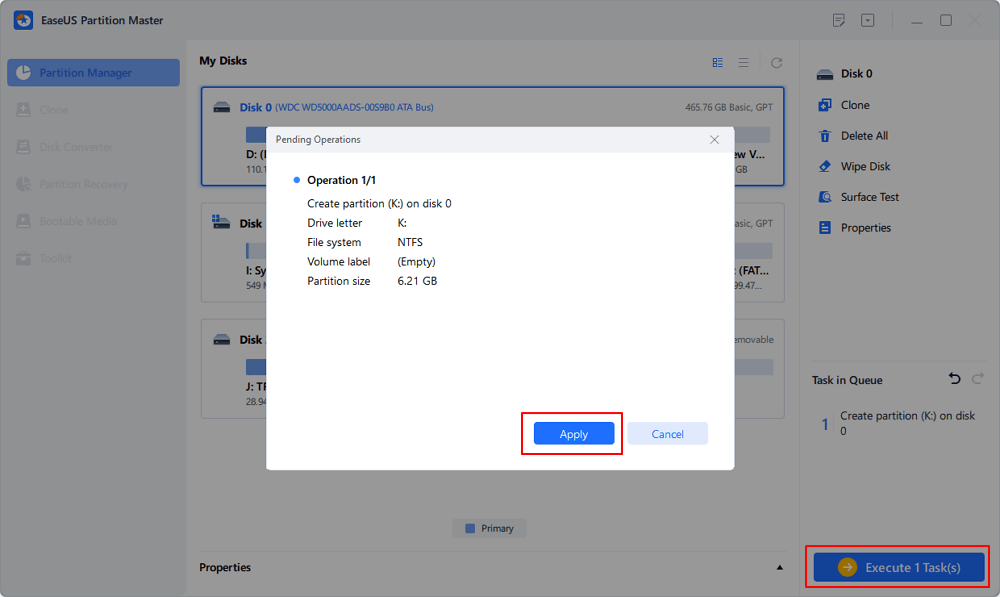
In order to ensure the best performance of an SSD, EaseUS Partition Master provides the 4K alignment function to align the 4K sectors on your SSD. You can optimize your SSD with this feature.
Way 2. Partition SSD with Disk Management
This method is used to shrink the existing partition and then use the unallocated space to create a partition. If the SSD hasn't been partitioned, you can create partitions on it directly.
Step 1. Open Disk Management.
Step 2. Right-click one SSD partition and select "Shrink Volume".
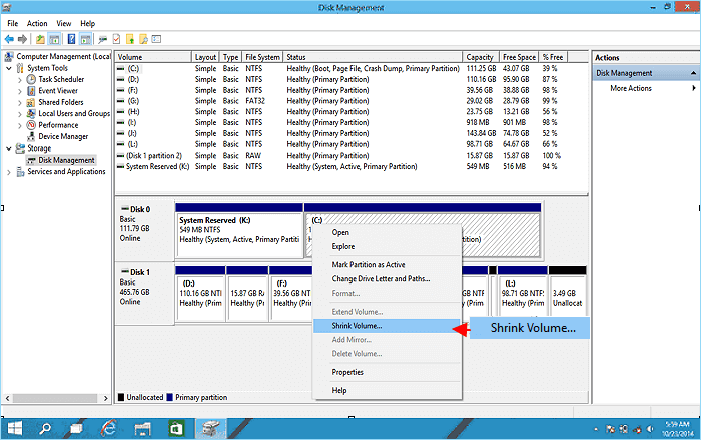
Enter the amount of space you want to shrink, then click on the "Shrink" button. (This would create unallocated space.)
Step 3. Right-click on the unallocated space and select "New Simple Volume".

Step 4. On the New Simple Volume Wizard interface, click "Next" and click "Next' to continue.
The unallocated space will be added to the new SSD partition.
Step 5. Assign Drive Letter or Path, then set the file system as NTFS. Click "Finish".

Wait for the process to complete, and this will create a new partition in your SSD. You can click the buttons below to let more people know about the ways to partition an SSD.
In the next part, you can learn the advantages of partitioning an SSD. Dive into learning if you should partition your SSD.
Is It a Bad Idea to Partition an SSD? Help!
Is it a bad idea to partition an SSD? I'm thinking around 300 GB for Windows and general apps, so I can reinstall Windows anytime without worry. But I've never heard about partitioning for like 10 years, so I'm wondering if it's not a thing anymore. - From Reddit
Should I partition my SSD for Windows 11/10? I want to use my SSD for gaming. Is it a good idea to partition SSD? The answer is Yes.
Advantages of Partitioning SSD:
By partitioning SSD, you'll enjoy all the advantages listed below. So I recommend you to do it, especially when you want to make additional partitions:
- Easier to Back Up and Restore System
- Better to Manage System and Personal Data
- Protect Data from System Crash or Failure Issues
- More Efficient to Use OS, Files
- EaseUS SSD Partition Tips:
- 1. If you have only one disk, create at least two partitions: one is for OS, the one is for data.
- 2. If you have 2 or more disks, partition SSD as the OS disk and use HDD as a data disk.
In a word, the best way to protect your OS and personal data is to install Windows and your various programs on the system partition and store your data, such as games, documents, pictures, music, and video files, on a new partition.
Partitioning SSD Is Easy, Take Steps to Make Use of Your SSD Now
On this page, we explained the advantages and the necessities of partitioning SSD and offered a complete guide to help you fully partition SSD in Windows 10/8/7.
To do so, you need first check the SSD state in Disk Management. Then, follow the respective solution to partition SSD with ease. For the easiest SSD partitioning tool, EaseUS Partition Master is recommended for you to try.
Following this tutorial, you'll safely and easily partition SSD on your computer. Take steps to make use of your SSD now.
FAQs About Partition SSD
If you have more questions on partitioning SSD, follow and find answers to the listed hot topics below:
1. Is it OK to partition SSD in Windows 11/10?
Sure, yes. It's OK to partition SSD as long as you need to use the SSD for Windows installation or data storage. If you only plan to use the SSD as an OS disk, you can just create one partition on it. However, if you want to split the OS with data on your computer, you can create 2 or 3 more partitions on the SSD disk to install Windows and save data in different partitions.
2. What does it mean to partition an SSD?
Partitioning SSD means splitting the SSD disk space into several sections with unallocated space, and with unallocated space, you can create partitions on the SSD for storing files and installing Windows OS.
The process of creating partitions and volumes on the SSD means to partition SSD. On an old SSD, you'll need to free up the SSD disk and make unallocated space to create new partitions on the disk.
3. Which partition is best for SSD?
Comparing SSD with HDD, SSD is faster and more reliable in data reading and writing. So it is faster in data trasnferring. So for SSD, we often suggest that you use the SSD as an OS partition, installing the Windows operating system on it so as to optimize the computer performance.
Here are two tutorials for you to follow:
Was This Page Helpful?
Roxanne is one of the main contributors to EaseUS and has created over 200 posts that help users solve multiple issues and failures on digital devices like PCs, Mobile phones, tablets, and Macs. She loves to share ideas with people of the same interests.
Jean is recognized as one of the most professional writers in EaseUS. She has kept improving her writing skills over the past 10 years and helped millions of her readers solve their tech problems on PC, Mac, and iOS devices.
Related Articles
-
Fix: Windows 10 Login Screen Loop (7 Ways)
![author icon]() Oliver/Mar 28, 2025
Oliver/Mar 28, 2025 -
Best Partition Recovery Software for Windows 11 ( Reliable and Easy)
![author icon]() Tracy King/Mar 29, 2025
Tracy King/Mar 29, 2025 -
Shred vs. Delete. What is the Difference?
![author icon]() Tracy King/Mar 28, 2025
Tracy King/Mar 28, 2025 -
Windows 11 Install: Windows Cannot be Installed To This Disk GPT
![author icon]() Tracy King/Mar 28, 2025
Tracy King/Mar 28, 2025